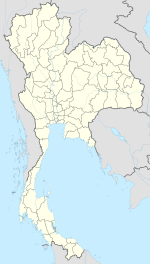Ko Libong
Ko Libong
เกาะลิบง | |
|---|---|
| Coordinates: 7°35′0″N 99°03′0″E / 7.58333°N 99.05000°E | |
| Country | Thailand |
| Province | Trang Province |
| District | Kantang District |
| Area | |
| • Total | 35 km2 (14 sq mi) |
| Population (2012) | |
| • Total | 3,500 |
| Time zone | UTC+7 (ICT) |
Ko Libong is an island in Thailand, and also of a sub-district of Kantang District which includes Mu Ko Libong Archipelago and a small section of the shoreline near Kantang.
Geography
Ko Libong, Trang's largest island, is 30 minutes by long-tail boat from Hat Yao Ban Chao Mai Pier.[1] Less visited than neighbouring isles, Ko Libong is known for its flora and fauna as much as for its beaches. The island is home to a small Muslim fishing community and has a few resorts on its west coast beaches.
On the east coast of Ko Libong at Laem Ju Hoi is a large area of mangroves protected by the Botanical Department as the Libong Archipelago Wildlife Reserve. The sea channels here are one of the last habitats of the rare dugong, and around 40 of them graze on the sea grass that flourishes in the bay.
Population
The majority of the population here is Muslim. They still have a tradition of burning coconut shells before the end of fasting in Ramadan. It is ancient tradition has since the past. Ban Mod Tanoy, a small muban of Ko Libong is only place in Thailand where this tradition continues.[2]
Economy
Bird nest collecting has been a money-making activity for Ko Libong residents for hundreds of years.[3] Ko Libong no longer has bird's nests, but collectors seek them on other islands in the Trang Sea, on Ko Muk, Ko Petra, and Ko Laolieng or in neighbouring provinces like Phatthalung, Krabi, and Phang Nga. Bird's nests are harvested three times a year, in February, April, and July-August. Each job takes about seven to eight days. When harvesting nests for the third time, harvesters wait until the chicks have flown away.[3]
Mu Ko Libong islands
| Nr | Island | Capital | Other Settlements | Area (km2) | Population[a] |
|---|---|---|---|---|---|
| 1 | Ko Kradan | Ko Kradan | Ao Yangalong, Ao Paradise Lost, Ao Niang, Ao Phai, Ao Rongthao, Ao Chonglom, | 2.44 | 400 |
| 2 | Ko Libong | Maphrao | Klong Wa, Batubute, Lungkhao | 35.00 | 3500[b] |
| 3 | Ko Muk | Ko Muk | Ao Klang, Ao Sapanyao, Ao Hua Laem, Ao Phangka, Ao Hua Non, Ao Farang, | 8.14 | 2000 |
| 4 | Other islands | Ko Nok | 0.5 | 0 | |
| Mu Ko Libong | Maphrao | Klong Wa, Batubute, Lungkhao, Ko Muk | 46.00 | 5900 |
See also
Notes
References
- ^ "KOH LIBONG ISLANDS". Tourism Authority of Thailand (TAT). Retrieved 27 August 2017.
- ^ "เผากะลาก่อนละศีลอดในเดือนรอมฎอน หนึ่งเดียวใน จ.ตรัง" (Video). Channel 8 (in Thai). 2017-06-21.
- ^ a b Panyaarvudh, Jintana (20 August 2018). "Scaling high for generations". The Nation. Retrieved 20 August 2018.
- ^ http://www.roughguides.com/destinations/asia/thailand/deep-south/trang-satun-islands/ko-libong
External links
 Ko Muk travel guide from Wikivoyage
Ko Muk travel guide from Wikivoyage
7°14′50″N 99°23′32″E / 7.24722°N 99.39222°E

